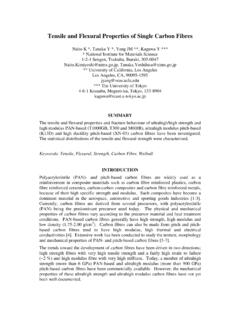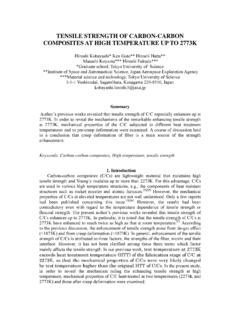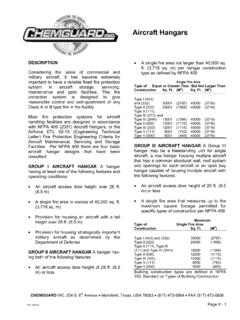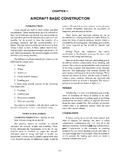Transcription of RECENT DEVELOPMENT OF STRUCTURAL HEALTH …
1 Back to Programme Back to Topic RECENT DEVELOPMENT OF STRUCTURAL HEALTH . monitoring technologies FOR aircraft . composite STRUCTURES IN JAPAN. N. Takeda and S. Minakuchi Dept. Advanced Energy, Graduate School of Frontier Sciences The University of Tokyo Mail Box 302, 5-1-5 Kashiwanoha, Kashiwa-shi, Chiba 277-8561, Japan SUMMARY. A review is presented on small-diameter optical fiber sensors for damage monitoring and STRUCTURAL HEALTH monitoring (SHM) of composite structures. Then, RECENT results in the current ACS-SIDE ( STRUCTURAL Integrity Diagnosis and Evaluation of Advanced composite Structures) project in Japan are presented on optical fiber based SHM for some feasible applications in aerospace applications. Keywords: Fiber optic sensor, STRUCTURAL HEALTH monitoring , composite structures, aerospace structures INTRODUCTION. SHM technologies have been studied extensively in order to assess the safety and the durability of the structures [1].
2 In addition, for weight saving of airplanes, CFRP. laminates are extensively being used for the primary structures. However, the maintenance cost of the structures may increase because of the complicated fracture process of the CFRP laminates. A new technological innovation to reduce the maintenance cost is a HEALTH monitoring or management system. At present, optical fiber sensors are most promising among all [2, 3]. This is because optical fibers have enough flexibility, strength and heat-resistance to be embedded easily into composite laminates. A most potential candidate for the sensing device is an optical fiber Bragg grating (FBG) sensor [4]. FBG sensors are very sensitive to non-uniform strain distribution along the entire length of the grating, which deforms the reflection spectrum from the FBG sensors. Taking advantage of the sensitivity, microscopic damages that cause non- uniform strain distribution in CFRP laminates can be detected.
3 When the optical fiber sensors are embedded into composite materials, however, there is a possibility of degradation in mechanical properties of host materials. Hence, the authors and Hitachi Cable, Ltd. have recently developed small-diameter optical fiber and its fiber Bragg grating (FBG) sensor that are suitable for embedment inside a lamina of composite laminates without strength reduction [5]. In the following, a brief summary is presented for some previous studies on the small-diameter FBG sensors for damage monitoring and SHM of composite structures. Then, some RECENT results in the current projects are presented on optical fiber based SHM for aerospace composite structures. DAMAGE DETECTION BY SMALL-DIAMETER FBG SENSORS. DEVELOPMENT of Small-Diameter Optical Fibers and FBG Sensors The small diameter optical fibers (both single-mode Polyimide Cladding and multi-mode) were developed and FBG sensors Coating were fabricated with these optical fibers (Fig.)
4 1). The Core optical fiber is with 40 m in cladding diameter and 52 m in polyimide coating diameter, which is easily embedded within one CFRP ply of typically 125 m in thickness. Such optical fibers have both mechanical m and optical properties similar to those of conventional 40 m optical fibers with 125 m in cladding diameter and 52 m do not cause any reduction in strength of composites Fig. 1. Small-diameter when embedded parallel to reinforcing fibers in optical fiber laminates [5]. When a small-diameter optical fiber is embedded inside a lamina, resin- 50 m rich regions cannot be found around the fiber, as shown in Fig. 2. Coating Cladding The polyimide coating relieves the stress concentration around the 0o Ply glass cladding with a proper combination of the stiffness and the Conventional Fiber 90o Ply Small-Diameter Fiber thickness. The coating is also Cladding Core FBG. highly compatible with epoxy or IT.
5 II. other high-temperature polymer IR. matrix of CFRP composites under d Refractive high-temperature exposure during Index fabrication and also in high- temperature use. m Then, FBG sensors were also 10 mm successfully developed with these single-mode small-diameter optical Fig. 2. Conventional and small-diameter optical fibers embedded in a CFRP lamina and fibers, where periodic gratings with small-diameter FBG sensors with fiber approximately m in space connection to conventional optical fibers. were inscribed in the gage section (typically 10 mm in length). When a broadband light is introduced from one end of the fiber, a narrow-band spectrum with a sharp wavelength peak corresponding to the grating spacing is obtained if uniform strain within the gage section can be assumed. FBG sensors are usually used to measure strain and/or temperature through the shift of the wavelength peak [4].
6 Damage Detection by FBG Sensors FBG sensors are very sensitive to non-uniform strain distribution along the entire length of the grating, which deforms the reflection spectrum from the FBG sensors (Fig. 3). Taking advantage of this sensitivity, Uniform strain Non-uniform strain Incident Transmitted Incident Transmitted microscopic damages that cause non- Light Light Light Light . uniform strain distribution in CFRP 1 . 1. 2. d= m . laminates can be detected. After the =C d=C . 3. 1 1 2. monitoring methodology was estab- IR IR. lished for cross-ply laminates [6, 7], transverse cracks were monitored in 0 1 0 2 1 3. Reflection spectrum is narrowband. Reflection spectrum becomes broadband. general quasi-isotropic laminates [8]. Strain can be determined from the This phenomenon is applied to detection wavelength shift. of damages. When an FBG sensor was embedded o in the -45 ply to detect transverse Fig.
7 3. Response of FBG sensors to uniform cracks in the adjacent 90o ply of and non-uniform strain distribution quasi-isotropic laminate [45/0/- 45/90]s (Fig. 4), a non-uniform Small-Diameter 0 Ply o Optical Fiber strain distribution due to the A. GFRP Tab initiation and evolution of transverse Polyimide Coating cracks caused the wavelength FBG Sensor -45 Ply o Cladding distribution in the reflected light A. (Fig. 5). While there were no 90 Ply Cross section at A-A. o 50 m transverse cracks, the spectrum kept its shape and the center wavelength Fig. 4. A small-diameter FBG sensor shifted corresponding to the applied embedded in the 45o ply for detection of strain. With increasing transverse transverse cracks in the adjacent 90o ply of crack density, the shape of the quasi-isotropic [45/0/-45/90]s laminate. reflection spectrum was distorted;. the intensity of the highest peak became small, some peaks appeared 15.
8 C ra ck D en sity (cm ). (E). (A) = , = -1. around it, and the spectrum became (B) = , = 10. broad. These experimental observa- (D ) (C) = , = tions could be well explained by the (D) = , = 5 (C ) (E) = , = theoretical prediction using the (A) (B ). : Tensile Strain calculated strain distribution and the : Transverse Crack Density 0. fiber optic theory [6-8]. The location 0 1 of transverse cracks in CFRP cross- Strain (% ). ply laminates could be also obtained when a chirped FBG sensor with (A) (B) (C) (D) (E). Reflectivity gradual change in grating period along the gage length was used [9]. The crack location can be well correlated with the wavelength in 0. the spectrum. 1551 1555 1553 1557 1553 1559 1553 1559. The same principal can be Wavelength (nm). applied to the detection of Fig. 5: Change in wavelength distribution of delamination or disbond in reflected light from the FBG sensor due to bondlines, which is the most the evolution of transverse cracks.
9 Important damage for STRUCTURAL design of composite laminates [10-13]. Figure 6 shows the [45/-45/0/90]s CFRP. laminate specimen with an embedded FBG sensor. The experimental results are shown in Fig. 7 for detection of free-edge delamination [11]. It should be noted that small- diameter optical fibers can be embedded in the laminates and penetrate the surface of the laminates to the outside without introducing any significant defect. The free-edge delamination grew alternatively at 0/90 and 90/90 interfaces under tension-tension fatigue loading. An initial single peak in the reflection spectrum was separated into two peaks, and the peak at longer wavelength grew as the edge delamination grew. The two peaks at shorter and longer wavelengths in the reflection spectrum correspond to the strain levels of the bonded and delaminated areas, respectively. This change in the reflection spectrum was found to be well predicted by the theoretical prediction.
10 This technique can be also applied to other types of delamination detection around stress-concentrated regions such as rivet holes. Multiple-mode damages including transverse cracks, delamination and splitting were also identified through an inverse analysis of the reflection spectrum in notched CFRP. laminates [14, 15] and in holed CFRP. laminates [16-18]. Debonding between honeycomb core and CFRP facesheets was also monitored using a small- diameter FBG or distributed sensor embedded in adhesive layer [19-21]. FBG sensors can also monitor the axial thermal residual stress during the Fig. 6. Schematic of [45/-45/0/90]s edge fabrication process of CFRP laminates. delamination specimen with an However, the reflection spectra are embedded FBG sensor. normally distorted after the fabrication of laminates, because of non- Normalized Intensity No. of Cycles = 20 x 10. 3. axisymmetric thermal residual stresses 1.










